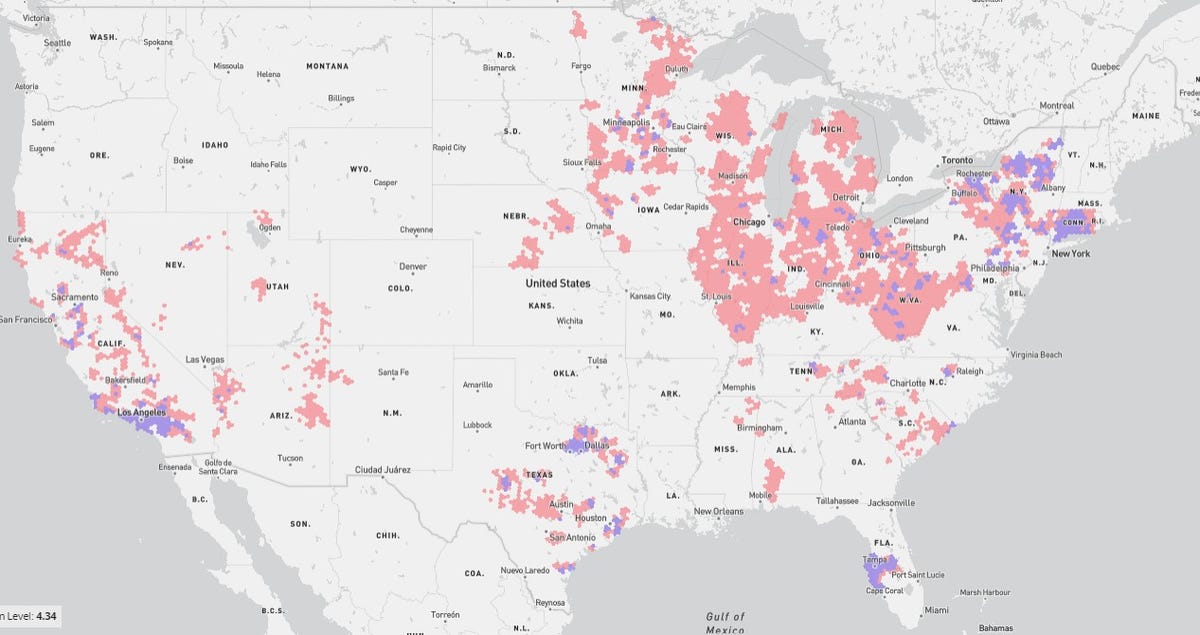Unavailable in Provider unavailable in
Frontier home internet rating
How we calculated our rating
Frontier’s fiber (purple) and DSL (pink) network coverage, per the most recent FCC data.
Frontier home internet availability and coverage
Frontier Communications is one of the nation’s largest internet providers, available in 25 states from Connecticut to California. Fiber service is currently available in 15 states, with serviceability largely reserved to metro areas, but ongoing expansion could bring Frontier Fiber to more states and locations in the future.
Until then, everywhere else serviceable for Frontier will have access to Frontier Internet. Again, that means DSL and its unpredictable, varying speeds. The following prices assume customer use of autopay.
Frontier internet plans and pricing
When will the price go up, and by how much? Pricing on all Frontier Fiber plans is month to month, but Frontier Internet, the copper DSL-based service, comes with a price lock for 24 months. After that, there is no guaranteed or preset price increase. That’s not to say your bill will never go up with either service, but price hikes aren’t predetermined and guaranteed like with many other ISPs.
Data caps, contracts and fees
All internet plans come with unlimited data and typically require no contract.
Frontier internet is not totally contract-free, however. Accepting a signup bonus, such as the $200 gift card currently available with select plans, will come with a term agreement. If you don’t want that, decline any special offers when you sign up.
As for added fees, your Wi-Fi router rental is included at no extra cost. Whole-home Wi-Fi, which includes up to two mesh Wi-Fi devices, is now available for an added $10 per month. That’s lower than many providers charge for simply renting a router.
Which Frontier Fiber plan is best?
Frontier Fiber now has four plan options ranging from 500Mbps to 5Gbps. Each plan has symmetrical upload speeds, a perk typically only available with fiber-optic service. Here are my recommendations for each plan:
- Fiber 500: Best for three to five users, streaming in HD, gaming online and working or learning remotely.
- Fiber 1 Gig: Best for five or more users and 10 or more devices, streaming in 4K on multiple devices, working or learning on multiple devices.
- Fiber 2 Gig: Best for a large household or those planning for the future and an increasing number of connected devices.
- Fiber 5 Gig: Best for a virtually unlimited number of devices. An uncompromisingly fast connection to satisfy any home.
You’ll notice a significant speed jump from one Fiber plan to the next, which can make it much easier to find the right plan for your needs. Also, at 500Mbps, Frontier has a faster entry-tier speed than many other fiber providers, including CenturyLink (200Mbps), AT&T (300Mbps) and Verizon Fios (also 300Mbps).
Fiber availability is expanding
Until recently, Frontier Fiber was reserved for parts of California, Florida, Indiana and Texas. Thanks to recent fiber-optic expansions, the service is now available in areas of 15 states and growing.
Though availability is still somewhat limited, Frontier has acknowledged the need for more significant fiber expansion and plans to extend service to more areas in the near future. “Frontier is targeting substantial fiber upgrades over the next several years to locations in and near Frontier’s footprint,” a spokesperson said.
No speed options with DSL, unfortunately
With Frontier Internet — that’s the DSL service — customers have one plan option starting at $65 monthly for “varying” speeds.
What determines available speeds? You guessed it — your address. More specifically, it’s your home’s distance from a local transmitting station. DSL speeds diminish over long distances, so the farther away you are, the lower your speeds are likely to be. Unfortunately, that means remote rural locations are often stuck with the lowest speeds.
How does Frontier internet compare?
As a DSL provider, Frontier may be a viable home internet option in rural areas. As mentioned above, DSL speeds vary widely by location, so the overall value of Frontier Internet and how it compares to other providers, will depend on what kind of speeds you can get.
As a fiber internet provider, Frontier has relatively low prices considering the speeds you get. With fiber plans starting at $50 per month, Frontier Fiber is on par with entry-level plans from AT&T Fiber ($55) and Verizon Fios ($50), yet slightly higher than Quantum Fiber’s starting price of $30. That said, Frontier does offer significantly faster speeds at 500Mbps versus the 300Mbps you’d get from AT&T and Verizon Fios or 200Mbps with Quantum Fiber.
In all likelihood, you won’t have the option of other DSL or fiber providers in Frontier service areas. Competing internet providers of the same technology typically avoid offering internet to the same address. However, you will find cable internet providers such as Spectrum or Xfinity available in many of the same areas as Frontier.
Cable beats DSL, fiber beats cable
Cable internet providers that you’ll find in Frontier service areas include Mediacom, Optimum, Spectrum and Xfinity, among others. Compared with cable internet, Frontier Internet is going to be slower and more expensive, especially considering the cost per Mbps. Most cable internet providers offer gigabit download speeds whereas Frontier Internet will come nowhere close to that. While cable internet plans can reach $100 a month or higher, the speeds you get for the price are likely to be a much better value.
Cable internet versus Frontier Fiber is a coin toss, depending on which cable provider is in your area. For example, Frontier Fiber has pricing similar to Xfinity’s cable internet plans on comparable speed tiers — both providers offer gigabit service starting for around $70 a month, for instance — but you’ll get faster upload speeds and unlimited data with Frontier Fiber. Spectrum’s internet service, on the other hand, is priced a bit higher than Frontier, but also comes with the conveniences of unlimited data and no contracts.
Ultimately, if Frontier Fiber is available in your area, I’d likely recommend it over cable internet service, especially if you’re considering the higher 500Mbps or gigabit speed tiers. The pricing is likely to be on par with or lower than similar tiers from a cable provider. The straightforward pricing and unlimited data give Frontier Fiber an advantage over most providers in general.
Frontier customer satisfaction is improving, slightly
Customer satisfaction scores are never pretty for cable and internet providers, but Frontier’s were downright ugly for a while there.
The American Customer Satisfaction Index ranked the provider last in 2019 and 2020 with scores of 55/100 in both years. In 2021, Frontier broke out of the bottom spot with a score of 57/100, edging out (former Altice brand) Suddenlink’s 55. In last year’s ACSI rankings, Frontier improved with a score of 61/100, passing CenturyLink, Mediacom and Optimum along the way. Frontier’s score was still below the industry average, but at least it has shown signs of improvement.
In the most recent ACSI report, scores were divided between fiber and non-fiber providers. Frontier Fiber still fell towards the bottom of the list at 74 — one point shy of the category average — but it’s worth noting that the score is drastically higher than the 61 Frontier received overall last year.
The good news stops there, however. As a “non-fiber provider” (read: Frontier Internet, the DSL service), Frontier again scored a 61. Again, that was below the category average and competing DSL providers including AT&T (72), Kinetic (70) and CenturyLink (62).
Recap of Frontier internet service
If you can overlook the low customer satisfaction ratings and slow DSL speeds, Frontier is probably worth considering, especially if fiber service is available. Frontier’s fiber internet offers speeds and pricing comparable to many other top providers, and fiber’s fast upload speeds and reliability gives it an edge over cable internet service.
Depending on the available speeds, Frontier’s DSL-based service could be the best internet option in rural areas where satellite is the only other way to connect. Reports of slow service, however, may make you want to give satellite internet another look.
Frontier internet FAQs
What’s the best Frontier internet deal?
How do I reset my Frontier router?

